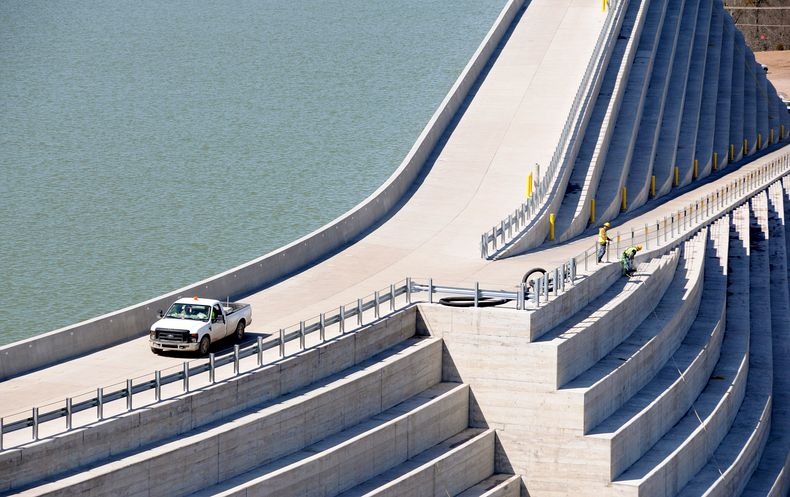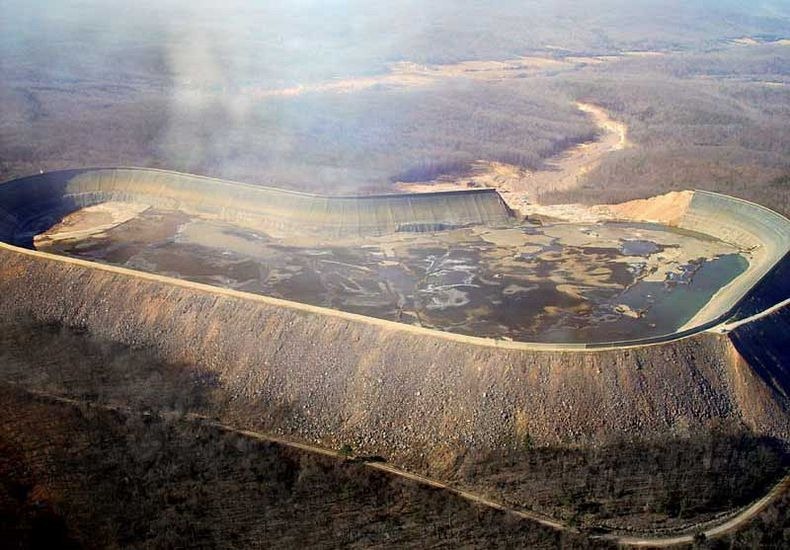Hydroelectric power stations are typically located near water sources, or on the source itself, such as dams on rivers. But Taum Sauk Hydroelectric Power Station is located more than 80 kilometers from the nearest water source – the Mississippi river. Built on top of the mountainous St. Francois region of the Missouri Ozarks, approximately 140 km south of St. Louis near Lesterville, Missouri, the Taum Sauk Hydroelectric Power Station is a pure pumped-storage hydroelectric plant, designed to help meet peak power demands during the day. During periods of high electrical demand, water stored in a kidney-shaped reservoir on top of Proffit Mountain is released through turbines into a lower reservoir, two kilometers away, on the East Fork of the Black River. At night, when electrical demand is low, the excess electricity available on the power grid is used to pump water back to the mountaintop. In essence, the power plant functions like a huge battery, storing excess power until it is needed.
Although pumped-storage hydroelectric power stations are found all over the world, the Taum Sauk plant is notable in that it is a pure pump-back operation – there is no natural primary flow available for generation, unlike most other pumped storage sites. It was among the largest such projects when it was built.
Construction of the Taum Sauk plant began in 1960 and operation began in 1963. The two original reversible pump-turbine units were each capable of generating 175 megawatts of power. They were upgraded in 1999 to units capable of 225 megawatts each. In 2005, the plant had to shut down when the upper reservoir suffered a catastrophic failure releasing 4 million cubic-meters of water in twelve minutes and sending a 20 foot crest of water down the Black River. The torrent of water roared into the Taum Sauk State park sweeping away the park superintendent's home and critically injuring his three small children.
The plant returned to service after a gap of four years. The rebuilt upper reservoir is now considered an engineering milestone, being the largest roller-compacted concrete dam in North America. To prevent another catastrophe, five back-up systems are now in place and nine cameras dot the reservoir's perimeter giving 24-hour surveillance to crews manning the facility around the clock.
Before the failure of the upper Reservoir visitors could usually drive to the top of Proffit Mountain and walk a ramp to an observation deck at the top of the reservoir. At the entrance gate there was also a museum highlighting the natural history of Missouri. The power plant was frequently visited by geology students because of a striking example of Precambrian/Cambrian unconformity in the rock layers exposed by the plant's construction.


The upper reservoir after the parameter breach. Photo credit
Aerial photos showing upper reservoir before and after failure. More pictures of the broken reservoir at this Wikipedia page.























My mamy swoje Taum Sauk na górze Żar :) (polecam zwiedzić!)
ReplyDeletethis is stupid. this will waste more energy than is created.
ReplyDeleteIt is not creating energy. It is storing energy from times of high production for times of low production elsewhere in the grid.
DeleteOf course that costs more energy to put the water there than it can be deliver, but is not a waste if that energy come from excess of power from renewable variable power sources like solar and wind.
Deletethis is so cool:]
ReplyDeleteAddition of wind and solar installations is fine, but without the addition of significant energy storage capacity such as the Taum Sauk station, they will be useless. Looking at the capacity factors for wind(32%) and solar(26%) it is obvious that these do NOT produce their rated power all the time. They will need to be overbuilt and the extra energy stored for the times the wind doesn't blow and the sun doesn't shine.
ReplyDeleteAs far as costs go, I have build several solar powered projects. To date, the storage systems (in my case batteries) and energy control systems have cost between 3 and 5 times what the solar panels cost. This was several years ago, in that time the solar panels have gotten cheaper, but the storage system costs have increased. When I see the entire system being addressed, then I will believe renewable energy will be possible.